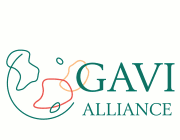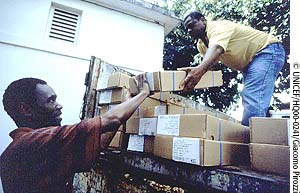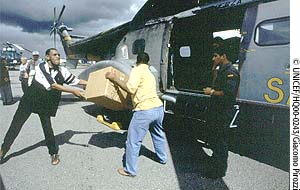 |
|
|
Immunization Focus August 2000 Return to Aug 2000 contents page GRASSROOTS Bringing it all together The first set of governments have been through the process of seeking support from the Vaccine Fund. Here’s how it felt in some African countries FOR anyone involved in applying to GAVI for support from the Vaccine Fund for grants, the past few months have been a hectic and exciting time. Tight schedules have been made tighter by face-to-face meetings, often between people who have never sat down together before, even though they all work in immunization in a given country. Data from sometimes scattered sources have been gathered together and reviewed to meet the requirements (see How GAVI and the Vaccine Fund will support countries ). But, whether governments joined the first round of proposals for support, or decided to wait for the second, the experience has been a useful one, according to many of those involved. And all the players have learnt lessons that will stand them in good stead for the future.
"It was a very good experience for all of us to get involved and get to know where we are," says Eva Kabwongera, UNICEF project officer for health in Kampala, Uganda. In Mozambique, says Miguel Aragon Lopez of UNICEF’s Maputo office, the process has been catalytic. For example, seeing that GAVI would supply autodestruct syringes with new and under-used vaccines, Mozambique – which has been using re-sterilisable syringes until now – has decided to match GAVI by using disposable ones for all the other vaccines it administers within its programme, such as BCG, measles and tetanus. Also, says Rose Macauley, technical adviser to the Mozambique immunization programme at the Ministry of Health, the process has triggered a rethink of the role of the national Immunization Coordination Committee (ICC). Before, this committee focused only on polio eradication. Now, the committee’s scope of work is to be extended. In a year in which Mozambique’s immunization services are still reeling from the effects of catastrophic flooding, the pace of recovery has been fast. Good news, but, of course, not everything in the region went perfectly. As with many large and highly devolved partnerships, GAVI’s partners’ activities in Africa suffered from some muddles and overlaps in the initial stages. Early in the year, governments and officials in certain countries were confused by uncoordinated messages from individual partners. No time to spare
To ensure the best use of the proposal process, the African regional offices of WHO and UNICEF held an informal meeting in Abidjan, Côte d’Ivoire, in mid-April. They clarified GAVI’s mechanisms and examined some of the key issues, such as how governments will plan to sustain support for immunization services beyond the five years of support from GAVI and the Vaccine Fund. Then WHO officials worked with individual countries to provide guidance on their proposals, focusing initially on those best equipped to provide the information needed in the short time available. Where there was enough time for discussion at higher political levels, in-person visits were strikingly productive. For example, in Tanzania, discussions with high-ranking officials in the health ministry resulted in a renewed and specific commitment by the government to sustaining immunization services. In some cases, consultants for the GAVI partners advised countries to wait for the second round to submit their proposals. Uganda was one of several such countries. "At first, we thought, why?" says Kabwongera. "But in the end we agreed that with more time it [our proposal] will be much better." Assembling scattered data Most of the required information for the proposal exists, says Kabwongera, but it was scattered and needed to be assembled. Uganda’s immunization services have suffered in recent years, possibly due to the introduction of policies such as the decentralization of health delivery services, and reforms of the civil service that resulted in some immunization workers being laid off. Some have now been reinstated, however, and, says Kabwongera, strategies have been developed to revitalize the immunization programme. Predictably, there is a range of views on how and whether GAVI and the Vaccine Fund should refine or develop the conditions for support. Perhaps the newest feature of the mechanism for funding countries is the "share" concept, which represents the Vaccine Fund’s contribution to the cost of fully immunizing one child (see How GAVI and the Vaccine Fund will support countries ). Nominally, this has been set at $20 per child. Some commentators ( 2 ) argue that the real cost varies from country to country, and that shares should therefore be scaled to take account of population size and other factors. Others welcome the share concept’s flexibility, contrasting it with the red tape that traditionally surrounds donor support. "The only conditionality is a commitment to really vaccinate the children," says Miguel Aragon Lopez in Mozambique. Which, after all, is what this entire effort is about. References 1. Global Alliance for Vaccines and Immunization and the Vaccine Fund: Guidelines on Country Proposals for Support. Available from the GAVI secretariat or at www.VaccineAlliance.org/download/guidelines.doc 2. African Perspectives on GAVI. Annex 7.2, Report of the Third Meeting of the GAVI Board, Oslo, June 14-16 2000. Presented by Lomamy Shodu, Zimbabwe Ministry of Health. www.VaccineAlliance.org/download/oslofullrept.doc
Return to August 2000 contents page |
|
|
|
Copyright © GAVI |

